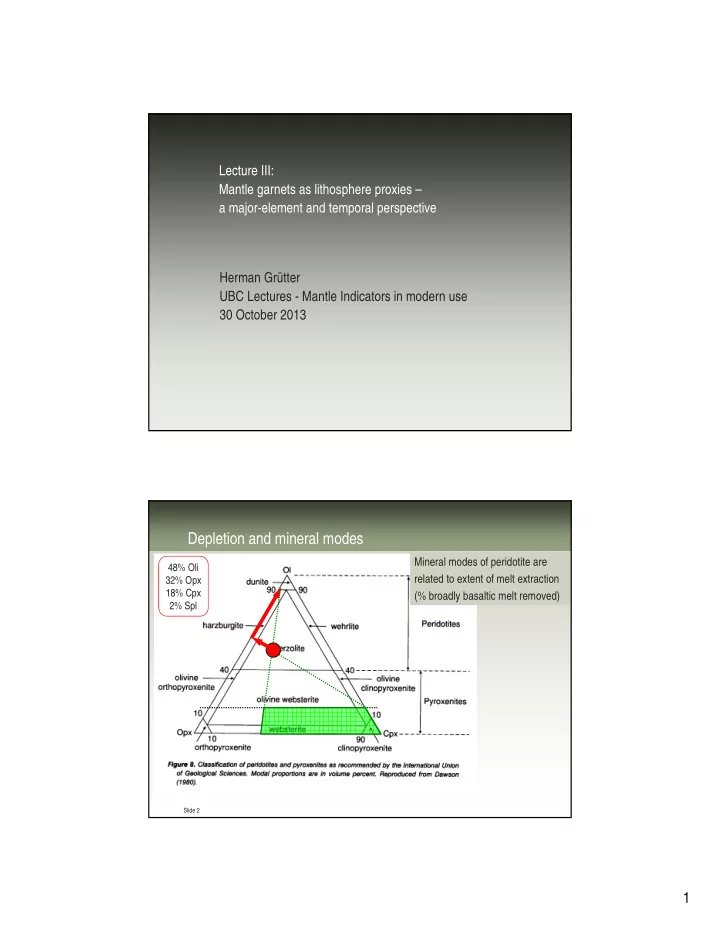

Lecture III: Mantle garnets as lithosphere proxies – a major-element and temporal perspective Herman Grütter UBC Lectures - Mantle Indicators in modern use 30 October 2013 Depletion and mineral modes Mineral modes of peridotite are 48% Oli related to extent of melt extraction 32% Opx 18% Cpx (% broadly basaltic melt removed) 2% Spl Slide 2 1
Peridotite solidus and degree of melting Cpx-Out Opx-Out Ol-Out ~20% melt ~40% melt 100% melt Ts +190 ° C Ts +75 ° C 1890 ° C Ts +655 ° C DUN HARZ Ts 1235 ° C LHERZ Variation of assemblage and melt fraction at 15 kbar for peridotite PHN-1611 Kushiro (1994) J Geol Soc Japan 100: 103-110 Slide 3 Mantle peridotite whole rock data Major-element depletion trend Depletion => basaltic melt extracted Residual depleted mantle has • Higher Mg/Fe 20% • Low Al/Cr • Low Ca 30% • Low Ti 40% % depletion almost linear Slide 4 2
Why choose garnet ? Garnet is the perfect proxy for mantle rocks • Occurs in a very wide range of mantle rock types (PER, PRX, ECL, MEG) • Wide P-T stability, including across graphite / diamond • Can retrieve major-element data and T (±P) at low unit cost Garnet Formula: X 3 Y 2 Si 3 O 12 ⇒ reflects Olivine or WR Mg# ⇒ ⇒ ⇒ X: Mg/(Mg+Fe) ⇒ ⇒ ⇒ ⇒ reflects Opx and/or Cpx presence X: Ca/(Ca+Mg+Fe) ⇒ ⇒ mantle thermometry ⇒ ⇒ X: Minor Mn, Ni ⇒ reflects Chromite or WR Cr# ⇒ ⇒ ⇒ Y: Cr/(Cr+Al) Slide 5 Near-fertile mantle (0 to 5% melting) 16 Alkali basalt sources Thin, hot lithosphere 12 Phanerozoic No diamonds Cr2O3 8 4 0 CaO 0 3 6 9 Pali-Aike, Antarctic, Vitim, China, Mongolia Slide 6 3
5 – 12% melt extracted (weak depletion) 16 Marginal kimberlites < 150 km lithosphere 12 Mid Proterozoic No diamonds Cr2O3 8 4 0 CaO 0 3 6 9 Gibeon Also in Proterozoic Angola-Brazil, Kundelungu Slide 7 5 – 20% melt extraction (Cpx still present) 16 Kimberlites 55 Up to 220 km lithosphere 12 Late Archean / Early Proterozoic L-dominant Cr2O3 8 Some diamonds – mostly E ? 4 0 CaO 0 3 6 9 Sloan-Nix Also in Finland, Prairie Creek, Majghawan, Kundelungu Slide 8 4
5 – 30% melt extraction (“Cpx-Out” at 20% melting) 16 Kimberlites Up to 200 km lithosphere 12 Archean 55 H significant Cr2O3 8 P ± E diamonds 4 0 CaO 0 3 6 9 Shandong, China Also in Botswana, Kuruman, Mbuji Mayi, Mali, South Slave Slide 9 5 – 50% melt extraction (“Opx-Out” at 40% melting ?) 16 Kimberlites Up to 200 km lithosphere 12 Early – Mid Archean 55 H strong, D present Cr2O3 8 P ± E diamonds 4 0 Aikhal + Udachnaya, with added eclogite CaO 0 3 6 9 Also in West KV, Venetia, central Slave Grütter, H. S., Apter D. B. and Kong J. (1999) Crust-Mantle coupling: Evidence from mantle- derived xenocrystic garnets. Proc. Seventh International Kimberlite Conference Vol 1, 307-313. Slide 10 5
Extent of depletion through time Francis (2003) Lithos 71: 135-152 20% 30% 40% Depleted residues Highest MgO (komatiite) melts Slide 11 Continents constant Growing continents 150K cooling since 3 Ga 240K cooling since 3 Ga Slide 12 6
Interpret the unknowns……. Sources (ABAS, KIM etc) Lithosphere depth Extent of depletion Possible lithosphere age Diamond associations Slide 13 Barometry and layering of depleted mantle…… Grütter, H., Latti, D. and Menzies, A. (2006) Cr-saturation arrays in concentrate garnet compositions from kimberlite and their use in mantle barometry. Journal of Petrology 47: 801-820. Slide 14 7
Whole-rock Mg/(Mg+Fe) during melt extraction 96 96 96 96 G10 G9 G10 G9 + Ti, Fe & Ca melt-related 94 94 94 94 metasomatism FO OLIVINE FO OLIVINE FO OLIVINE FO OLIVINE 92 92 92 92 90 90 90 90 88 88 88 88 86 86 86 86 0 0 1 1 2 2 3 3 4 4 5 5 6 6 0.0 0.0 1.0 1.0 2.0 2.0 GAR CA_INT (wt%) GAR CA_INT (wt%) GAR TiO2 (wt%) GAR TiO2 (wt%) Garnet and Olivine in Kaapvaal & Lesotho peridotite xenoliths (n = 888) Eaton et al (2009) The elusive lithosphere-asthenosphere boundary (LAB) beneath cratons. Lithos 109:1-22. Slide 15 Questions ? 8
Recommend
More recommend